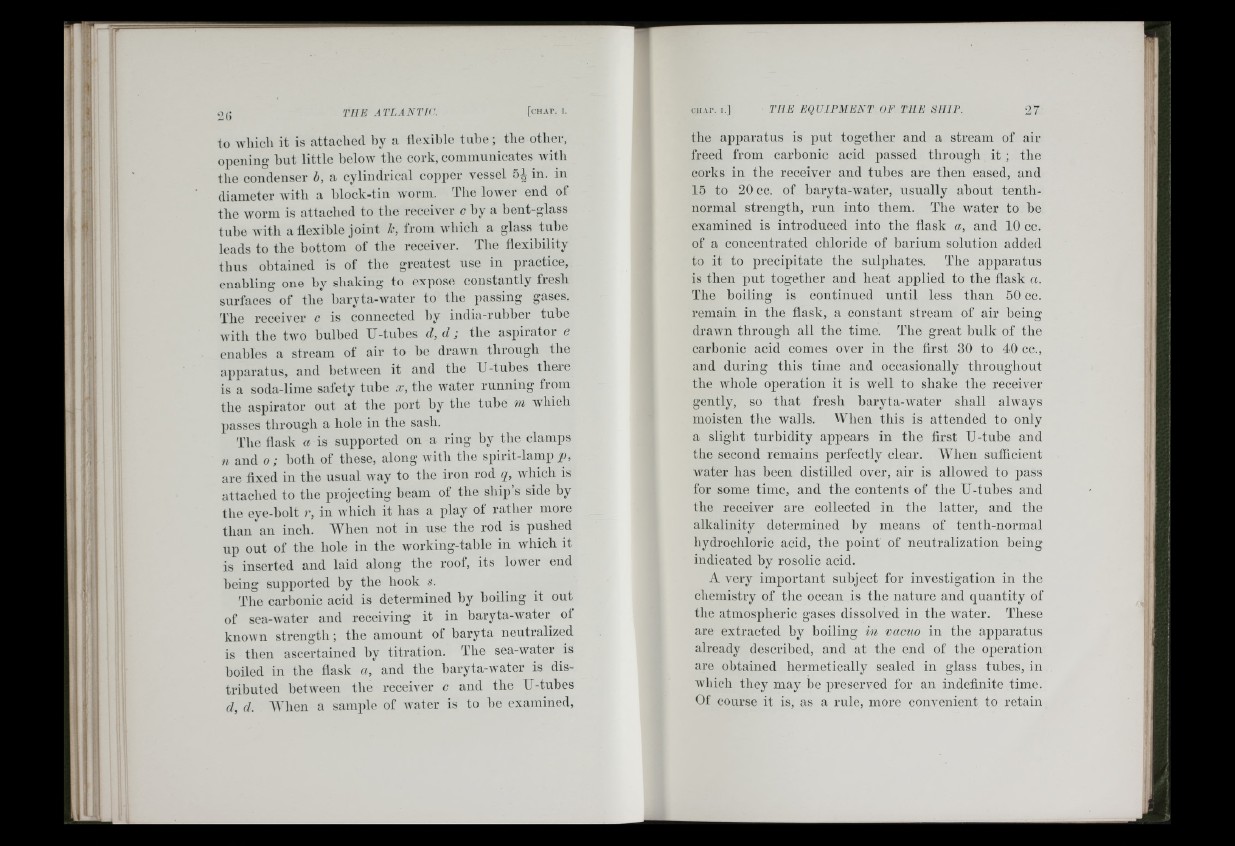
1!;
i- 5i ■' i
i ]■'
« \
to Avhich it is attached l)y a tlexihlc tuhe ; the otlier,
opening hut little helow the cork, communicates witli
the condenser b, a cylindrical copper vessel 54 m. in
diameter Avith a hlock-tin worm. The lower end of
the Avorm is attached to the receiver c hy a hent-glass
tuhe Avith aiiexihle joint k, from Avhicli a glass tuhe
leads to the hottom of the receiver. The flexibility
thus obtained is of the greatest use in practice,
enabling one hy shaking to expose constantly fiesh
surfaces of the haryta-water to the passing gases.
The receiver c is connected liy india-ruhher tuhe
with the two bulbed U-tuhes d, d ; the aspirator e
enables a stream of air to he drawn through the
apparatus, and hetween it and the U-tuhes tliei-e
is a soda-lime safety tuhe x, the water running from
the aspirator out at the port hy the tuhe ni Avliich
passes through a hole in the sash.
The flask a is supported on a ring by the clamps
n and o ; both of these, along with the spirit-lamp p ,
are fixed in the usual Avay to the iron rod q, which is
attached to the projecting beam of the ship’s side hy
the eye-holt r, in which it has a play of rather more
than "an inch. When not in use the rod is pushed
up out of tlie hole in the Avorking-tahle in which it
is inserted and laid along the root, its lower end
heing supported by the hook s.
The carbonic acid is determined hy hoiling it out
of sea-Avater and receiving it in baryta-Avater ot
knoAvn strength; the amount of baryta neutralized
is then ascertained hy titration. The sea-Avater is
hoiled in the flask a, and the haryta-Avater is distributed
between the receiver c and the U-tubes
d, d. AYhen a sample of Avater is to he examined.
the apparatus is put together and a stream of air
freed from carbonic acid passed through it ; the
corks in the receiver and tubes are then eased, and
15 to 20 cc. of haryta-water, usually about tenthnormal
strength, run into them. The Avater to he
examined is introduced into the flask a, and 10 cc.
of a concentrated chloride of barium solution added
to it to precipitate the sulphates. The apparatus
is then put together and heat applied to the flask a.
The boiling is continued until less than 50 cc.
remain in the flask, a constant stream of air being
draAvn through all the time. The great hulk of the
carbonic acid comes over in the first 30 to 40 ce.,
and during this time and occasionally throughout
the AA’hole operation it is well to shake the receiver
gently, so that fresh haryta-Avater shall alAA’ays
moisten tlie Avails. When this is attended to only
a slight turbidity appears in the first U-tuhe and
the second remains perfectly clear. AA^lien sufficient
Avater has heen distilled over, air is allowed to pass
for some time, and the contents of the U-tuhes and
the receiver are collected in the latter, and the
alkalinity determined hy means of tenth-normal
hydrochloric acid, the point of neutralization heing
indicated by rosolic acid.
A very important subject for investigation in the
chemistry of tlie ocean is the nature and quantity of
the atmospheric gases dissolved in the Avater. These
are extracted hy hoiling in vacuo in the apparatus
already described, and at the end of the operation
are obtained hermetically sealed in glass tubes, in
Avhicli they may he jireserved for an indefinite time.
Of course it is, as a rule, more convenient to retain